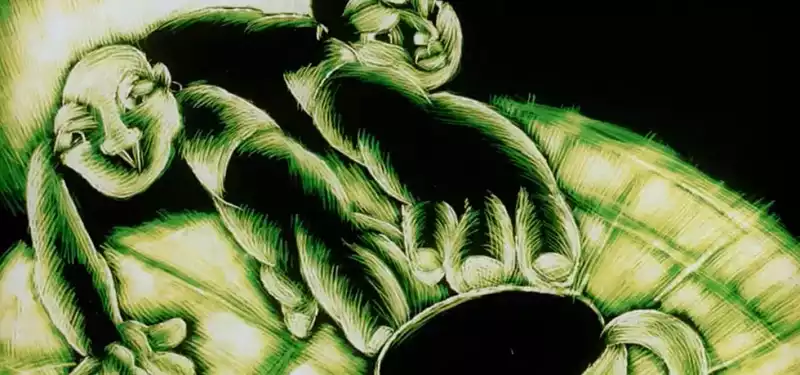Aug 30, 2016
Ottawa Animation Festival 40th Anniversary Film: "Two Sisters
The Ottawa International Animation Festival, North America's largest and most important animation event, is celebrating its 40th anniversary this year.
To celebrate, the festival has commissioned international animation historians, programmers, and critics to write an essay about each of the Grand Prize winning films. In partnership with the festival, Cartoon Brew will present one essay each week leading up to the festival, September 21-25, 2016. We have already featured essays on "The Man Who Planted Trees" and "Hen, His Wife," and today we present the 1992 award-winning film "Two Sisters," directed by Caroline Leaf.
For more information about attending Ottawa, visit animationfestival.ca.
Caroline Leaf's powerful and important direct animation Two Sisters (1991) is a celebration of work done by women. [This animation tells the story of two sisters, Marie and Viola, who live alone on an island. One day, a stranger comes to visit, completely disrupting their solitude and the rhythm of their daily lives and causing them to panic.
In the animation process, Leaf creates illustrative images by etching directly onto 70mm film emulsion. He cuts something up and pushes it aside. And in the case of the film emulsion, this violence of carving is what ultimately makes the light shine (literally, when the film is projected). Both Leaf's animation process and Marie and Viola's animated narrative deeply explore the power of the female hand in its role of strength to convey experience, to experience life itself, to "take in" and "let through" light.
Almost every shot in the entire film contains a detailed description of a character's hand. From the opening shot of the stranger's hands and fingers swimming in the blue sea and reaching toward us, to the final scene of Marie holding the keys to the house and Viola's hands typing quickly, the hands are constantly front and center in the visual foreground and in the frame. From the opening scene of The Stranger, we cut to Marie's hands lovingly combing Viola's hair and later pouring her coffee. We see Viola's hands typing furiously and are made aware that she is a writer. Marie and Viola's hands often take up the entire frame, each joint and small finger gesture magnified for us.
Just as we see Viola, the writer, leave footprints by typing, we also see Leaf's footprints made for us on the screen. The film creates a space for us to reflect on the labor of the women artists behind the book (and the film). We see the typing of Viola by Leaf's hands as they etch the film emulsion. The women's mark-making and shared experiences play and flourish through the harnessed and fierce power of their hands and their collaborative work. Leaf and Viola's hands communicate with each other in an intense, loving, and attentive way. Marie's hands, on the other hand, communicate the invisible domestic reproductive labor of women by caring for Viola, cooking, cleaning, and "putting the house in order."
The power of the female hand as a true force is exemplified by the harsh sound of Viola's typewriter, the engraved and magnified gestures accompanying her fingers and knuckles, typing so intensely that she almost breaks the vessel that communicates with the outside world. Viola continues to type intensely, seemingly moving toward the catharsis of repetitive finger movement.
It is hard not to think of the repetitive (and sometimes cathartic) movement of the animation process itself, which is sculpted for us by the leaf and takes us frame by frame. The 70mm film was re-photographed, giving it space to swim in the light without being rushed through animation at 24 illustrations per second. Caroline Leaf spent a year and a half designing the film.
At the climactic moment when the stranger arrives at Viola and Marie's house, he enters an unlocked door, causing the sisters to panic. Marie, in particular, is shown to be upset because she has kept Viola isolated from the outside world, fearing Viola's facial disfigurement and the public's reaction.
The stranger says he just wants to see Viola. Viola turns away in embarrassment and covers her face with her hands. The stranger's hands reach out to Viola. His left hand pulls Viola's hands away from her face so that her face appears to be illuminated by the light. His right hand cupped Viola's face in a friendly embrace because he was in awe that he had the privilege of seeing his most beloved writer.
The importance of the hand as a site of power continues to be further emphasized throughout these moments of electrifying embrace. After this, Viola's hand holds Marie's face and Marie's hand holds and kisses Viola's hand. These hands not only leave traces of the experience of Viola's typing, but also of life itself: tactile, tactile, touching, feeling, learning, and connecting with others.
The stranger invites Viola to go outside and into the light. Viola goes outside for the first time in a long time and is surrounded by the bright, shining, warm light of the sun. The emulsion etched into the film invites the warm light of the projector to pass through. Viola signs her copy of the book: "To the stranger who saw me in the sunlight. The audience can see Viola as the celluloid emulsion is scraped away. The light itself allows for a direct animation process, bringing us into the life of these sisters.
When Viola returns inside, the sisters are back as they were at the beginning of the film, but something within them has changed and transformed. Viola is typing furiously and Marie is sitting in a rocking chair, holding the house keys tightly. The fingers clutching and holding the keys show us that there is a direct correlation between the two. The hands of the woman in (and behind) Caroline Leaf's "Two Sisters" are the keys to sharing one's experiences, leaving footprints, experiencing life, and connecting with others.
.



Post your comment